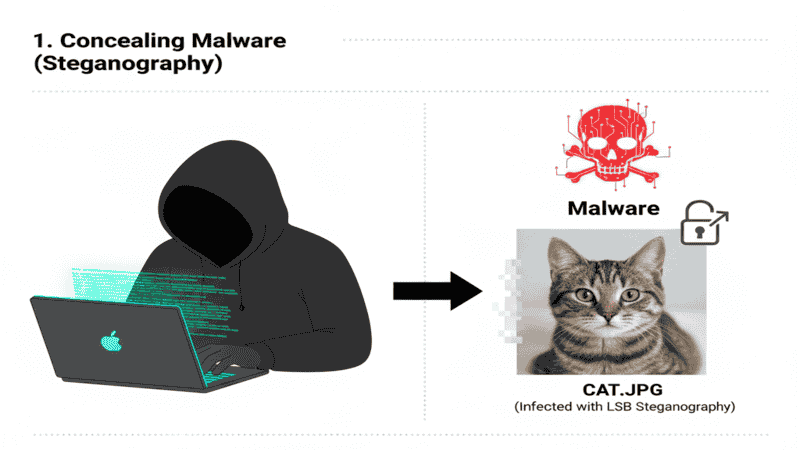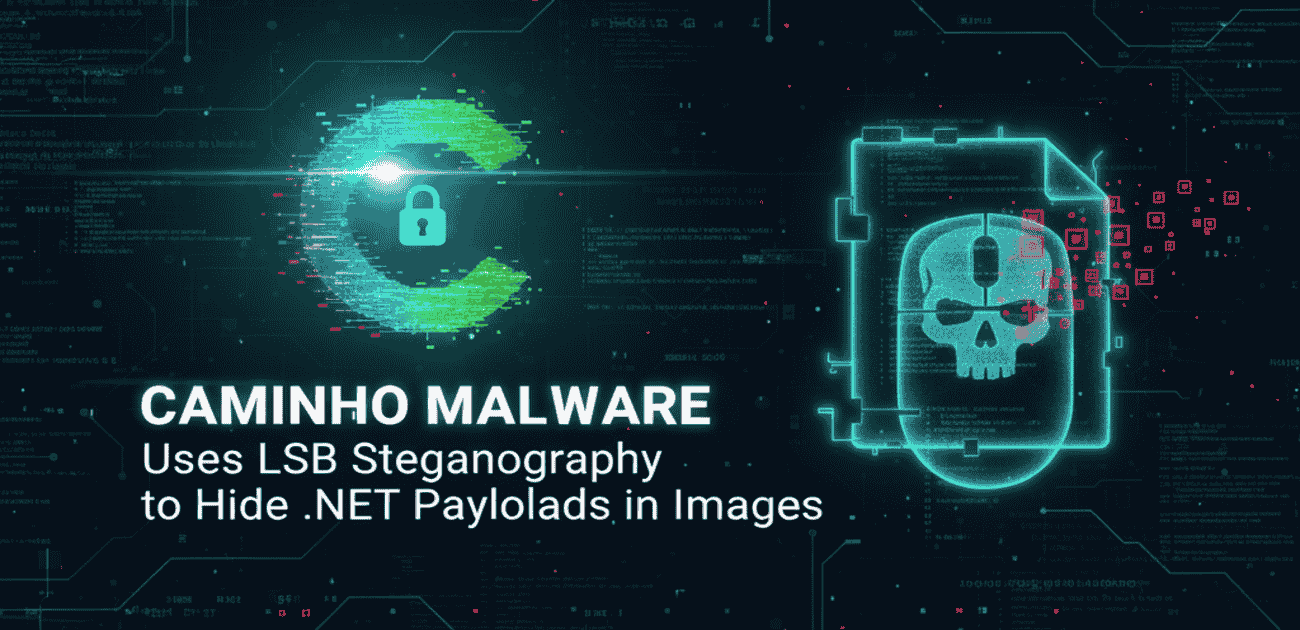Brazilian malware operation leverages advanced steganographic techniques to conceal malicious payloads within seemingly harmless image files, targeting organizations across South America, Africa, and Eastern Europe
October 25, 2025 – Global Threat
New Caminho malware loader uses LSB steganography to hide .NET payloads in images
Delivers REMCOS RAT, XWorm, and Katz Stealer through sophisticated multi-stage attacks
Organizations across South America, Africa, and Eastern Europe at risk
As of October 25, 2025, cybersecurity researchers have identified a sophisticated malware operation originating from Brazil that leverages advanced steganographic techniques to conceal malicious payloads within seemingly harmless image files. The Caminho loader, active since at least March 2025, represents a growing threat to organizations across South America, Africa, and Eastern Europe, delivering diverse malware families including REMCOS RAT, XWorm, and Katz Stealer through an intricate multi-stage infection chain.
This alarming development underscores the evolving sophistication of malware delivery mechanisms, where attackers exploit legitimate platforms and advanced obfuscation techniques to evade traditional security controls. The campaign demonstrates operational maturity through continuous infrastructure rotation, obfuscation updates, and the abuse of legitimate services for malicious hosting.
KEY FACTS
WHAT HAPPENED:
- LSB steganography technique: Malware uses Least Significant Bit steganography to extract concealed .NET assemblies from image files
- Multi-stage infection chain: Campaign begins with spear-phishing emails containing compressed archives with JavaScript or VBScript files
- Business-themed social engineering: Uses fake invoices and quotation requests to trick recipients into executing malicious code
- Legitimate platform abuse: Downloads steganographic images from archive.org, a trusted non-profit digital archive platform
- Memory-only execution: Extracted loader operates entirely in memory, implementing extensive anti-analysis checks
- Loader-as-a-Service model: Functions as a service operation enabling multiple customers to deploy different malware families
- Geographic expansion: Confirmed victims span Brazil, South Africa, Ukraine, and Poland
- Infrastructure rotation: Continuous infrastructure rotation and obfuscation updates to evade detection
WHO’S AFFECTED:
- Organizations in South America: Primary targeting region with Brazil as origin point
- African organizations: South Africa confirmed as victim region
- Eastern European entities: Ukraine and Poland confirmed as affected areas
- Enterprise organizations: Businesses receiving spear-phishing emails with malicious attachments
- Government agencies: Potential targets for advanced persistent threats
- Financial institutions: High-value targets for credential theft and financial fraud
IMMEDIATE IMPACT:
- Credential theft capability: Katz Stealer harvests login credentials and sensitive information
- Remote access control: REMCOS RAT provides complete system control to attackers
- Data exfiltration risk: XWorm enables unauthorized data access and theft
- Persistence mechanisms: Scheduled tasks re-execute infection chain every minute
- Anti-detection measures: Virtual machine detection, sandbox environment identification, and debugging tool recognition
- Fileless execution: Defeats traditional file-based detection mechanisms
- Minimal forensic artifacts: Leaves minimal traces on compromised systems
TABLE OF CONTENTS
- Breaking / Latest Update
- Attack Details & Methods
- Technical Analysis & Steganography
- Major Incidents & Case Studies
- Federal Response & Warnings
- Expert Analysis & Reports
- Future Outlook & Impact
- Critical Recommendations
BREAKING / LATEST UPDATE
In a statement released on October 25, 2025, Arctic Wolf analysts confirmed the identification of a sophisticated malware operation from Brazil leveraging advanced steganographic techniques to conceal malicious payloads within image files. The Caminho loader has been active since at least March 2025, representing a growing threat to organizations across multiple continents.
The campaign demonstrates operational maturity through continuous infrastructure rotation, obfuscation updates, and the abuse of legitimate services for malicious hosting. Analysis of 71 Caminho loader samples reveals consistent Portuguese-language code throughout, with variable names like “caminho” (path), “persitencia” (persistence), and “minutos” (minutes), strongly indicating Brazilian origins.
Significantly, the malware validates payload architecture before injecting the final payload into legitimate Windows processes such as calc.exe, establishing persistence through scheduled tasks that re-execute the infection chain every minute. This fileless execution approach defeats traditional file-based detection mechanisms and leaves minimal forensic artifacts on compromised systems.
The operational patterns observed across multiple campaigns strongly suggest Caminho functions as a Loader-as-a-Service operation rather than a single threat actor’s tool, enabling multiple customers to deploy different malware families using the same delivery infrastructure.
ATTACK DETAILS & METHODS
The Caminho malware campaign begins with carefully crafted spear-phishing emails containing compressed archives that house JavaScript or VBScript files. These initial scripts use business-themed social engineering lures such as fake invoices and quotation requests to trick recipients into executing the malicious code.
Upon execution, the script retrieves an obfuscated PowerShell payload from Pastebin-style services, which then downloads steganographic images from archive.org, a legitimate non-profit digital archive platform. The use of trusted platforms allows the malware to evade traditional security controls that rely on domain reputation and blocklists.
Primary Attack Vectors:
- LSB Steganography (100%): Uses Least Significant Bit steganography to extract concealed .NET assemblies from image files. The PowerShell script searches for a specific BMP header signature within downloaded JPG or PNG files, then iterates through every pixel to extract RGB color channel values that encode the hidden binary data.
- Social Engineering: Business-themed spear-phishing emails with fake invoices and quotation requests to trick recipients into executing malicious code
- Legitimate Platform Abuse: Downloads steganographic images from archive.org to evade traditional security controls
- Memory-Only Execution: Extracted loader operates entirely in memory, implementing extensive anti-analysis checks
The malware’s most notable innovation lies in its use of Least Significant Bit (LSB) steganography to extract concealed .NET assemblies from image files. The first four bytes specify the payload length, followed by the Base64-encoded malicious assembly.
According to technical analysis, the extracted loader operates entirely in memory, implementing extensive anti-analysis checks including virtual machine detection, sandbox environment identification, and debugging tool recognition. The malware validates payload architecture before injecting the final payload into legitimate Windows processes.
TECHNICAL ANALYSIS & STEGANOGRAPHY
Arctic Wolf analysts identified the loader’s most notable innovation in its use of Least Significant Bit (LSB) steganography to extract concealed .NET assemblies from image files. The PowerShell script searches for a specific BMP header signature within downloaded JPG or PNG files, then iterates through every pixel to extract RGB color channel values that encode the hidden binary data.
The steganographic technique involves:
- Image processing: PowerShell script processes downloaded images to extract hidden data
- Pixel iteration: Iterates through every pixel to extract RGB color channel values
- Binary encoding: RGB values encode the hidden binary data using LSB technique
- Payload extraction: First four bytes specify payload length, followed by Base64-encoded malicious assembly
- Memory execution: Extracted payload operates entirely in memory without file system artifacts
Code snippet demonstrating the LSB extraction technique:
$plectonephric = [Drawing.Bitmap]::FromStream($biological);
$muffin = New-Object Collections.Generic.List[Byte];
for ($tazias = 0; $tazias -lt $plectonephric.Height; $tazias++) {
for ($lidger = 0; $lidger -lt $plectonephric.Width; $lidger++) {
$elayle = $plectonephric.GetPixel($lidger, $tazias);
$muffin. Add($elayle.R);
$muffin. Add($elayle.G);
$muffin. Add($elayle.B)
}
};
Figure: Demonstration of LSB steganography technique used by Caminho malware to hide malicious payloads within seemingly harmless image files
This fileless execution approach defeats traditional file-based detection mechanisms and leaves minimal forensic artifacts on compromised systems, making it extremely difficult for security teams to detect and analyze the malware.
MAJOR INCIDENTS & CASE STUDIES
The Caminho malware campaign demonstrates operational maturity through continuous infrastructure rotation, obfuscation updates, and the abuse of legitimate services for malicious hosting. The diverse payload delivery includes REMCOS RAT deployed via bulletproof hosting command-and-control infrastructure on AS214943 Railnet LLC, XWorm delivered from malicious domains, and Katz Stealer credential-harvesting malware.
Confirmed victims span Brazil, South Africa, Ukraine, and Poland, with geographic expansion coinciding with the adoption of steganographic techniques in June 2025. The campaign demonstrates operational maturity through continuous infrastructure rotation, obfuscation updates, and the abuse of legitimate services for malicious hosting.
The standardized invocation interface accepts arbitrary payload URLs as arguments, enabling multiple customers to deploy different malware families using the same delivery infrastructure. Infrastructure analysis reveals the reuse of identical steganographic images across campaigns with varying final payloads, confirming the modular service architecture.
FEDERAL RESPONSE & WARNINGS
While no specific federal directive has been issued for the Caminho malware, cybersecurity agencies emphasize the importance of implementing layered security controls to defend against advanced steganographic attacks. The extensive use of legitimate platforms like archive.org presents unique challenges for traditional perimeter defenses.
Recommended security measures include:
- Block JavaScript and VBScript files: Prevent execution of JavaScript and VBScript files within archive attachments
- Deploy email sandboxing: Implement email sandboxing that executes scripts and follows network connections
- Monitor PowerShell activity: Enable monitoring of PowerShell with encoded commands
- Enable memory scanning: Deploy memory scanning capabilities to detect in-memory payloads
- Network monitoring: Monitor network traffic for suspicious connections to legitimate platforms
Federal agencies emphasize that blanket blocking of legitimate platforms may impact business operations while selective URL blocking proves ineffective against the operators’ demonstrated infrastructure rotation capabilities.
EXPERT OPINIONS AND OFFICIAL REPORTS
According to Arctic Wolf analysts, the Caminho malware represents a significant evolution in malware delivery techniques, leveraging advanced steganographic methods to evade traditional security controls. The use of legitimate platforms like archive.org demonstrates the sophistication of modern threat actors in exploiting trusted services.
Security researchers emphasize that the Loader-as-a-Service business model enables multiple threat actors to leverage the same sophisticated delivery infrastructure, significantly increasing the scale and impact of malicious campaigns. The modular architecture allows for rapid adaptation and customization of attack techniques.
Industry experts note that the extensive use of legitimate platforms presents unique challenges for traditional perimeter defenses, as blanket blocking may impact legitimate business operations while selective URL blocking proves ineffective against demonstrated infrastructure rotation capabilities.
FUTURE OUTLOOK AND IMPACT ON US BUSINESSES
Security experts predict that steganographic malware techniques will continue evolving as threat actors seek new methods to evade detection. The success of the Caminho campaign demonstrates the effectiveness of hiding malicious payloads within seemingly harmless image files.
Emerging Threats (Next 6-12 Months):
- Advanced steganography techniques: Threat actors developing more sophisticated methods to hide malicious code within legitimate files
- Legitimate platform abuse: Increased exploitation of trusted services for malicious hosting and delivery
- Loader-as-a-Service expansion: Growth of malware delivery services enabling multiple threat actors
- Anti-detection evolution: Enhanced techniques to evade sandboxing and analysis environments
Industry Response:
Security vendors are developing advanced detection capabilities to identify steganographic techniques and hidden payloads within image files. Machine learning algorithms are being trained to detect subtle changes in image files that may indicate hidden malicious content.
Long-Term Implications (12-24 Months):
- Enhanced detection capabilities: Development of advanced tools to detect and analyze steganographic malware
- Legitimate platform security: Increased security measures on trusted platforms to prevent abuse
- Regulatory requirements: Potential regulations requiring enhanced security measures for legitimate hosting services
- Industry collaboration: Increased information sharing between security vendors and platform providers
CRITICAL RECOMMENDATIONS
For US Businesses:
Immediate Actions (Next 30 Days):
- Block suspicious file types: Implement policies to block JavaScript and VBScript files within archive attachments
- Deploy email sandboxing: Implement email sandboxing solutions that execute scripts and follow network connections
- Enable PowerShell monitoring: Deploy monitoring solutions for PowerShell with encoded commands
- Implement memory scanning: Enable memory scanning capabilities to detect in-memory payloads
- Network traffic monitoring: Deploy network monitoring to detect suspicious connections to legitimate platforms
- User awareness training: Conduct training on identifying suspicious emails and attachments
- Incident response planning: Develop procedures for responding to steganographic malware attacks
For Individual Users:
- Email security awareness: Be cautious of emails with compressed attachments, especially from unknown senders
- File type verification: Verify file types and sources before opening attachments
- Software updates: Keep all software and security tools updated to latest versions
- Backup procedures: Maintain regular backups of important data and systems
- Report suspicious activity: Report any suspicious emails or system behavior to IT security teams
For Government Contractors and Critical Infrastructure:
- Enhanced monitoring: Implement advanced monitoring solutions for detecting steganographic techniques
- Network segmentation: Isolate critical systems from potential attack vectors
- Incident reporting: Establish procedures for reporting and responding to advanced malware attacks
- Security assessments: Conduct regular security assessments to identify vulnerabilities
- Collaboration: Share threat intelligence with government agencies and industry partners
RESOURCES AND REPORTING
Emergency Response Resources:
- FBI Internet Crime Complaint Center (IC3): www.ic3.gov
- CISA Cybersecurity Reporting: central@cisa.dhs.gov
- Arctic Wolf Security: arcticwolf.com
- Microsoft Security Response Center: msrc.microsoft.com
- Malware Analysis Resources: virustotal.com
RELATED ARTICLES
- Samsung Galaxy S25 Zero-Day Vulnerability Exploited at Pwn2Own Ireland 2025
- Advanced Malware Protection Guide for Organizations
CONCLUSION
The Caminho malware campaign represents a significant evolution in malware delivery techniques, leveraging advanced steganographic methods to evade traditional security controls. The use of legitimate platforms like archive.org demonstrates the sophistication of modern threat actors in exploiting trusted services for malicious purposes.
The Loader-as-a-Service business model enables multiple threat actors to leverage the same sophisticated delivery infrastructure, significantly increasing the scale and impact of malicious campaigns. The modular architecture allows for rapid adaptation and customization of attack techniques, making it extremely difficult for security teams to detect and analyze.
Organizations must implement layered security controls including blocking JavaScript and VBScript files within archive attachments, deploying email sandboxing, monitoring PowerShell with encoded commands, and enabling memory scanning capabilities to detect in-memory payloads. The extensive use of legitimate platforms presents unique challenges for traditional perimeter defenses.
Stay informed about evolving malware threats. Subscribe to CyberUpdates365 for real-time alerts about advanced malware techniques, steganographic attacks, and expert guidance on protecting your organization.
Stay Protected
Subscribe to CyberUpdates365 for real-time cybersecurity alerts and expert guidance on protecting your organization from advanced malware threats.
Expert analysis • Breaking alerts • Security recommendations
Updated on October 25, 2025 by CyberUpdates365 Editorial Team
This is a developing story. CyberUpdates365 will provide updates as additional information about the Caminho malware campaign becomes available.


Leave a Reply